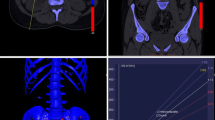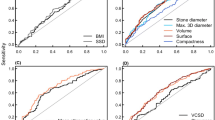Abstract
The objective of this study was to assess the value of dual X-ray absorptiometry (DXA) in comparison to non contrast computed tomography (NCCT) density as possible predictors of upper urinary tract stone disintegration by shock wave lithotripsy (SWL). This study included 100 consecutive patients, with solitary renal stone 0.5–2 cm or upper ureteral stone up to 1 cm. DXA to calculate stone mineral density (SMD) and stone mineral content (SMC) was done. NCCT was performed to measure Hounsfield units (HU). SWL was performed with an electromagnetic lithotripsy, plain X-ray documented disintegration after SWL. Successful treatment was defined as stone free or complete fragmentation after 1 or 2 sessions of SWL. The impact of patients age, sex, body mass index, stone laterality, location, volume, length, mean SMC and SMD, HU and Hounsfield density (HD), skin to stone distance (SSD) and number of shock waves were evaluated by univariate and multivariate analysis. Only 76 patients were available for follow-up. Success of disintegration was observed in 50 out of 76 patients (65.8 %). On multivariate analysis, SMC and number of shock wave were the significant independent factors affecting SWL outcome (p = 0.04 and p = 0.000, respectively). SMC as detected by DXA is a significant predictor of success of stone disintegration by SWL. SMC measured by DXA is more accurate than HU measured by CT. Patients with high stone mineral content (SMC greater than 0.65 g) should be directly offered another treatment option.

Similar content being viewed by others
References
Lingeman JE, Matlaga BR, Evan AP (2007) Surgical management of urinary lithiasis. In: Wein AJ, Kavoussi LR, Novick AC, Partin AW, Peters CA (eds) Campbell-Walsh Urology. W. B. Saunders, Philadelphia, pp 1431–1507
Dretler SP, Polykoff G (1996) Calcium oxalate stone morphology: fine tuning our therapeutic distinctions. J Urol 155(3):828–833. pii:S0022-5347(01)66319-5
Mostafavi MR, Ernst RD, Saltzman B (1998) Accurate determination of chemical composition of urinary calculi by spiral computerized tomography. J Urol 159(3):673–675. pii:S0022-5347(01)63698-X
Mandhani A, Raghavendran M, Srivastava A, Kapoor R, Singh U, Kumar A, Bhandari M (2003) Prediction of fragility of urinary calculi by dual X-ray absorptiometry. J Urol 170(4 Pt 1):1097–1100. doi:10.1097/01.ju.0000086092.38214.24
Blake GM, Fogelman I (1998) Applications of bone densitometry for osteoporosis. Endocrinol Metab Clin North Am 27(2):267–288
Dalla Palma L, Pozzi-Mucelli R, Stacul F (2001) Present-day imaging of patients with renal colic. Eur Radiol 11(1):4–17
Dretler SP, Spencer BA (2001) CT and stone fragility. J Endourol 15(1):31–36. doi:10.1089/08927790150500926
Gupta NP, Ansari MS, Kesarvani P, Kapoor A, Mukhopadhyay S (2005) Role of computed tomography with no contrast medium enhancement in predicting the outcome of extracorporeal shock wave lithotripsy for urinary calculi. BJU Int 95(9):1285–1288. doi:10.1111/j.1464-410X.2005.05520.x
Pareek G, Armenakas NA, Panagopoulos G, Bruno JJ, Fracchia JA (2005) Extracorporeal shock wave lithotripsy success based on body mass index and Hounsfield units. Urology 65(1):33–36. doi:10.1016/j.urology.2004.08.004
Pareek G, Hedican SP, Lee FT Jr, Nakada SY (2005) Shock wave lithotripsy success determined by skin-to-stone distance on computed tomography. Urology 66(5):941–944. doi:10.1016/j.urology.2005.05.011
Pareek G, Armenakas NA, Fracchia JA (2003) Hounsfield units on computerized tomography predict stone-free rates after extracorporeal shock wave lithotripsy. J Urol 169(5):1679–1681. doi:10.1097/01.ju.0000055608.92069.3a
Williams JC Jr, Kim SC, Zarse CA, McAteer JA, Lingeman JE (2004) Progress in the use of helical CT for imaging urinary calculi. J Endourol 18(10):937–941
Conflict of interest
The authors declare that they have no conflict of interest.
Author information
Authors and Affiliations
Corresponding author
Rights and permissions
About this article
Cite this article
Hameed, D.A., Elgammal, M.A., ElGanainy, E.O. et al. Comparing non contrast computerized tomography criteria versus dual X-ray absorptiometry as predictors of radio-opaque upper urinary tract stone fragmentation after electromagnetic shockwave lithotripsy. Urolithiasis 41, 511–515 (2013). https://doi.org/10.1007/s00240-013-0596-1
Received:
Accepted:
Published:
Issue Date:
DOI: https://doi.org/10.1007/s00240-013-0596-1




